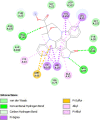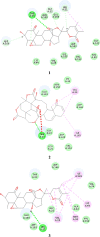Nephroprotective effect of Physalis peruviana L. calyx extract and its butanolic fraction against cadmium chloride toxicity in rats and molecular docking of isolated compounds
- PMID: 36707799
- PMCID: PMC9881262
- DOI: 10.1186/s12906-023-03845-9
Nephroprotective effect of Physalis peruviana L. calyx extract and its butanolic fraction against cadmium chloride toxicity in rats and molecular docking of isolated compounds
Abstract
Background: Cadmium is an environmentally toxic metal that has deleterious effects on both animals and humans due to its accumulation in different body tissues. Physalis peruviana L. fruit and calyx contain many active constituents which are used traditionally for their different biological activities. Based on the traditional uses of P. peruviana L. calyx, we aimed to evaluate the nephroprotective effect of their 80% aqueous methanol extract (AME) and n-butanol fraction (Bu.F.) against cadmium chloride-induced nephrotoxicity in rats and to correlate this activity with phytoconstituents isolated using molecular docking studies.
Methods: The n-butanol fraction of P. peruviana L. calyx was fractionated using various chromatographic techniques and the isolated compounds were identified based on their chemical and spectroscopic data. The nephroprotective activity was assessed using cadmium chloride-induced nephrotoxicity in the rat model, by measuring some important parameters such as body weight, kidney weight, serum urea, and creatinine levels, oxidative stress markers, inflammatory markers, and histopathological examinations of kidney tissue. Molecular docking studies of the isolated compounds were performed.
Results: Three withanolides named 4 β-hydroxywithanolide E (1), Physalin B (2) and 3α, 14β-dihydroxywithaphysalin N (3) were isolated and identified from the n-butanol fraction of P. peruviana L calyx extract. The extract and its butanol fraction significantly improved the serum kidney function markers and tissue oxidative status including malondialdehyde (MDA), reduced glutathione (GSH) and catalase (CAT). Additionally, the extracts significantly decreased the levels of tumor necrosis factor-alpha (TNF-α) and nuclear factor kappaB (NF-κβ). Moreover, the histological changes were ameliorated by the extracts. The molecular docking study showed that the isolated compounds displayed a remarkable inhibitory activity against IκB kinase.
Conclusion: The AME and its butanol fraction of P. peruviana L calyx showed potential nephroprotective activity against cadmium chloride-induced nephrotoxicity which is correlated at least in part to its considerable withanolides content.
Keywords: Anti-inflammatory; Antioxidant; Nephrotoxicity; Physalis peruviana L calyx; Withanolides.
© 2023. The Author(s).
Conflict of interest statement
The authors declare that they have no known competing financial interests or personal relationships that could have appeared to influence the work reported in this paper.
Figures







Similar articles
-
The potential protective role of Physalis peruviana L. fruit in cadmium-induced hepatotoxicity and nephrotoxicity.Food Chem Toxicol. 2014 Dec;74:98-106. doi: 10.1016/j.fct.2014.09.013. Epub 2014 Sep 28. Food Chem Toxicol. 2014. PMID: 25265456
-
Effect of Physalis peruviana L. on cadmium-induced testicular toxicity in rats.Biol Trace Elem Res. 2014 Jun;159(1-3):278-87. doi: 10.1007/s12011-014-9955-1. Epub 2014 Apr 13. Biol Trace Elem Res. 2014. PMID: 24728876
-
A multi-analytical platform based on pressurized-liquid extraction, in vitro assays and liquid chromatography/gas chromatography coupled to high resolution mass spectrometry for food by-products valorisation. Part 1: Withanolides-rich fractions from goldenberry (Physalis peruviana L.) calyces obtained after extraction optimization as case study.J Chromatogr A. 2019 Jan 11;1584:155-164. doi: 10.1016/j.chroma.2018.11.055. Epub 2018 Nov 24. J Chromatogr A. 2019. PMID: 30553502
-
Withanolides from the genus Physalis: a review on their phytochemical and pharmacological aspects.J Pharm Pharmacol. 2020 May;72(5):649-669. doi: 10.1111/jphp.13209. Epub 2019 Dec 11. J Pharm Pharmacol. 2020. PMID: 31826333 Review.
-
Ethnotherapeutic Uses and Phytochemical Composition of Physalis peruviana L.: An Overview.ScientificWorldJournal. 2021 Oct 11;2021:5212348. doi: 10.1155/2021/5212348. eCollection 2021. ScientificWorldJournal. 2021. PMID: 34671227 Free PMC article. Review.
Cited by
-
Nutrients, Phytochemicals, and In Vitro Biological Activities of Goldenberry (Physalis peruviana L.) Fruit and Calyx.Plants (Basel). 2025 Jan 22;14(3):327. doi: 10.3390/plants14030327. Plants (Basel). 2025. PMID: 39942889 Free PMC article.
-
Antioxidative Function of Zinc and Its Protection Against the Onset and Progression of Kidney Disease Due to Cadmium.Biomolecules. 2025 Jan 27;15(2):183. doi: 10.3390/biom15020183. Biomolecules. 2025. PMID: 40001486 Free PMC article. Review.
References
-
- Zhang WN, Tong WY. Chemical constituents and biological activities of plants from the genus physalis. Chem Biodivers. 2016;13(1):48–65. - PubMed
-
- Lim TK. Edible Medicinal and Non-Medicinal Plants. Dordrecht: Springer; 2013. Physalis peruviana; pp. 300–9.
-
- Singh N, Singh S, Maurya P, Arya M, Khan F, Dwivedi DH, Saraf SA. An updated review on Physalis peruviana fruit: Cultivational, nutraceutical and pharmaceutical aspects. Indian J Nat Prod Resour. 2019;10(2):97–110.
-
- Ertürk Ö, Çol Ayvaz M, Can Z, Karaman Ü, Korkmaz K. Antioxidant, antimicrobial activities and phenolic and chemical contents of Physalis peruviana L. from Trabzon Turkey. IJPER. 2017;51(3):213–216.
-
- Hassan HA, Ghareb NE, Azhari GF. Antioxidant activity and free radical-scavenging of cape gooseberry (Physalis peruviana L.) in hepatocellular carcinoma rats model. Hepatoma Res. 2017;3:27–33.
MeSH terms
Substances
LinkOut - more resources
Full Text Sources
Miscellaneous

